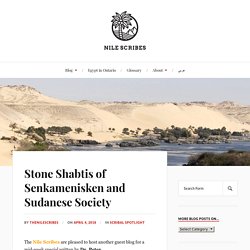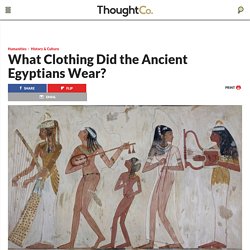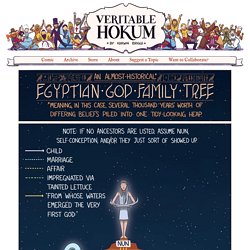

Great Female Rulers of Ancient Egypt. Women in ancient Egypt had more rights than in any other ancient culture and were valued with greater respect.

This is evident not only in the physical evidence and inscriptions but in their religion. Some of the most powerful and important deities in the Egyptian pantheon are female and some versions of the creation myth itself present the goddess Neith, not the god Atum, as the creator. The most popular and influential religious tale in Egypt was the story of Osiris and how he was brought back to life by his sister-wife Isis. The Hittites. Stone Shabtis of Senkamenisken and Sudanese Society - Nile Scribes. The Nile Scribes are pleased to host another guest blog for a mid-week special written by Dr.

Peter Lacovara, who contributes a brief response to recently proposed ideas on the shabti production of the Twenty-Fifth Dynasty kings, including some on display in the Royal Ontario Museum (ROM). Guest Scribe: Dr. Peter Lacovara A recent blog post on the top five Nubian objects in the Royal Ontario Museum sparked my interest, as number one was a shabti figure of King Senkamanisken (Fig. 1).
This shabti was one of 410 stone funerary figurines from his tomb at Nuri Pyramid 3 that was a gift from the Sudanese Government to the ROM in 1926 made after the division with the Harvard University-Museum of Fine Arts Expedition to the Sudan that excavated the royal cemetery (1). Figure 1: Serpentine shabti of King Senkamanisken (ROM Object number: 926.15.1) Ankhsenamun. We've Been Debating Foie Gras Since Ancient Times Gastro Obscura.
Book Egypt in its African Context. Amarna Era Chronological Conundrum: Dating Akhenaten’s Death and the Length of Horemheb’s Reign–Part I. New Egypt discovery could change chronology of the Pharaohs and beliefs about Amenhotep III and IV. A team of Spanish and Egyptian archaeologists has made an unexpected discovery in a southern Egyptian tomb, which could lead to a reinterpretation of Pharaonic chronology and change our understanding of the Pharaoh’s Amenhotep III and his son, Amenhotep IV.

The scientists, led by Spanish archaeologist Francisco Martin Valentin, were excavating the remains of a wall and columns of the mausoleum of a minister of the 18th Dynasty (1569-1315 BC) in the province of Luxor, when they discovered the names of Amenhotep III and Amenhotep IV carved together . According to Mr Valentin, the joint inscription suggests that they reigned together. The inscription that suggests Amenhotep III and Amenhotep IV reigned together. Photo credit: Egypt’s Ministry of State for Antiquities Affairs. Ancient Egyptian Animals Had a Place in the Afterlife. Here’s Why. - The New York Times. Still, the curators have taken pains to erase some popular misconceptions. The ancient Egyptians did not worship entire species — not even their splendid cats, whose mummies, well represented in the exhibition, sometimes appear in casings bearing traces of their original gilding.
“These weren’t your run-of-the-mill New York City cat that would sleep by the window,” said Dr. Anthony Fischetti, a staff doctor and the head of diagnostic imaging and radiology at the Animal Medical Center in Manhattan, who helped identify the mummified remains. “Ancient cats tended to have a longer nose and greater length to their skull.” Photo. Egyptian Clothing - What Clothing Did Egyptians Wear? Ancient Egyptian tomb painting and writing reveal a variety of clothing depending on status and activity.

There are wrap-around garments for ancient Egyptians made from a length of cloth. Scientists thought ancient Egyptian mummies didn’t have any DNA left. They were wrong. Ancient Egyptian mummies preserve many details of the deceased: facial features, signs of illness, even tattoos.

But not, it seemed, DNA. After trying repeatedly to extract it, may scientists were convinced that the hot desert climate and, perhaps, the chemicals used in mummification destroyed any genetic material long ago. The Egyptian Goddess Isis, Found in India. One of the great, largely untold adventure stories of late antiquity is the journey to the East, from Egypt’s Red Sea ports, across the open ocean for 40 days and 40 nights, to the legendary entrepôt of Musiris, on India’s southwestern or Malabar coast, in what is now modern state of Kerala.

This was a great feat of navigation, a technological leap forward comparable to the discovery of the Americas or Francis Drake’s circumnavigation of the globe. Mysterious Musiris. The Egyptian God Family Tree – Veritable Hokum. First: I opened a store!

It has a poster of this, as well as updated versions of the Norse and Greek god family trees I did a while back. More to come soon. Next, a disclaimer: this family tree isn’t, strictly speaking, historically accurate, because what we think of as The Egyptian Pantheon is really a whole bunch of similar-but-not-identical pantheons which were mostly based in individual cities – Thebes, Heliopolis, Memphis, etc. – and went through a lot of changes over their 3000+ year history. It’s as nice a chart as I could make after smooshing together a bunch of those similar-but-not-identical pantheons into one image, but it also contains at least a half-dozen gods who were in charge of their own version of this pantheon, and a bunch of others who could be related to each other in totally different ways depending on when and where you asked. And now that I’ve disclaimed historical responsibility, onto What I Know About Those Gods Up There: Nun.
What Explains Our Obsession With Ancient Egypt? Photo EGYPTOMANIAA History of Fascination, Obsession and FantasyBy Ronald H.

FritzeIllustrated. 444 pp. Reaktion Books/University of Chicago Press. $35. Egypt has exerted a peculiar charm since ancient times. The Greeks and Romans deferred to it as a far older civilization, whose monuments and writing seemed both baffling and magical. Egypt unearths 7,000-year-old lost city. Egypt has unearthed a city more than 7,000 years old and a cemetery dating back to its first dynasty in the southern province of Sohag, the antiquities ministry has said.

The find could be a boon for Egypt’s ailing tourism industry, which has suffered a series of setbacks since the uprising that toppled the autocrat Hosni Mubarak in 2011, but remains a vital source of foreign currency. The city is likely to have housed high-ranking officials and grave builders. Interpreting the Murals of Egypt through the Eyes of the Hopi. There has to be something missing in our explanation of the murals of Egypt.

Why are there so many symbols— snakes, birds with human heads, feathers, buzzards, life symbols, monkeys, scarabs, balances, a young man, two twins, and masked individuals— that only a select few can understand? Whoever created the murals must have been trying to communicate with all of us in a simple fashion or a universal language, something that we could all understand. Betrest Wikipedia. Benerib Wikipedia. 4,000-year-old Ancient Egyptian manuscript measuring more than 8ft has been rediscovered in Cairo.
The oldest known Egyptian leather manuscript, dating back some 4,000 years, has been rediscovered at the Egyptian Museum in Cairo after it was pulled from a dusty, old storage box, where it had been lost for around 70 years. The precious text contains fine quality depictions of supernatural beings which predate the famous drawings of the Egyptian Book of the Dead. Discovery News reports that the manuscript measures 2.5 meters (8.2 feet) in length, making it the longest text ever found. It exceeds the next longest text by just 2 inches – an ancient pre-nuptial agreement between a couple due to be married, which sets out how the wife will be provided for, should the marriage fail.
“Taking into account that it was written on both sides, we have more than 5 meters (16.4 feet) of texts and drawings, making this the longest leather roll from ancient Egypt,” Wael Sherbiny, the Belgium-based independent scholar who made the finding, told Discovery News. By April Holloway. Does Chinese Civilization Come From Ancient Egypt? On a cool Sunday evening in March, a geochemist named Sun Weidong gave a public lecture to an audience of laymen, students, and professors at the University of Science and Technology in Hefei, the capital city of the landlocked province of Anhui in eastern China.
But the professor didn’t just talk about geochemistry. He also cited several ancient Chinese classics, at one point quoting historian Sima Qian’s description of the topography of the Xia empire — traditionally regarded as China’s founding dynasty, dating from 2070 to 1600 B.C. The Magic of Heka: Ancient Egyptian Rituals That Have Crossed Cultures and Time. Magic has always been a mysterious way to achieve goals and was often thought to make dreams come true. Hidden in the Hieroglyphs: Is Ancient Egyptian a Lost Language? The ancient Egyptian language is not just one set of symbols which people find on papyri bookmarks at museums. It's a complicated system of symbols which changed over time.
Moreover, the words found on ancient reliefs became a basis for other languages. Hieroglyphs were nothing more than a very sophisticated system of known symbols in ancient Egypt.